Explainable Machine Learning-Based Electric Field Strength Mapping for Urban Environmental Monitoring: A Case Study in Paris Integrating Geographical Features and Explainable AI
Abstract
1. Introduction
1.1. The Motivation
1.2. Objectives
- By leveraging explainable AI, our models do more than just estimate electric field strength; they reveal the key urban factors—such as population density, building characteristics, and urbanization levels—that most significantly influence electric field strength. This transparency fosters trust in the models and facilitates their practical application.
- Our unique dataset goes beyond traditional field strength measurements. It incorporates rich geographical features, providing a holistic view of the electric field distribution. This comprehensive approach sets a new standard for the accuracy of prediction.
- Our research generates detailed electric field strength maps for large urban areas. These maps are not only informative, they are actionable tools. They empower individuals, organizations, and policymakers to make informed decisions about urban planning, public health initiatives, and proactive risk management strategies.
- Understanding these key determinants empowers policymakers to develop targeted and effective interventions. This can include crafting regulations or urban design strategies that mitigate potential risks associated with RF radiation.
1.3. Related Work
2. Methods
2.1. Dataset
- ID: This unique identifier helps track each antenna location.
- EMF (V/m): This variable represents the total electromagnetic field strength (summed across all bands) measured at each antenna.
- Urbanization degree: This variable, coded with 8 values based on [25], indicates the level of urbanization in a specific area.
- Population (expressed as the number of people per 100 m × 100 m): This variable, extracted from a population density dataset [26], represents the number of people living within a 100 m × 100 m square around each antenna.
- Built-up volume (m3): Derived from a spatial dataset [27], this variable indicates the total volume of buildings in the area surrounding each antenna.
- Built-up surface (m2): This variable, extracted from a dataset [28], represents the total surface area of buildings in the area, including residential and non-residential uses.
- Building height (m): This variable, derived from a building height dataset [29], indicates the average building height in the vicinity of each antenna.
- Settlement characteristics: This variable, based on the GHS-BUILT-C dataset [30], describes the inner structure and functionality of the built environment around each antenna.
2.2. Preprocessing Data
Standardization and Sampling
2.3. Machine Learning Algorithms
2.3.1. k-NN
2.3.2. Neural Networks
2.3.3. Decision Trees (DTs)
2.4. Accuracy Criteria
2.5. Heatmaps
2.6. SHapley Additive exPlanations
- Local accuracy: When the transformation is identified with x, then the explanation model matches the original model, i.e., .
- Missingness: Simply, if , then . This means that this feature has no attributable impact when . Missingness implies that a missing feature receives an attribution of zero.
- Consistency: The values remain constant unless there is a change in the contribution of a feature. More importantly, the consistency property says that if a feature becomes more important in making predictions, its Shapley value should also go up or stay the same.
3. Results
3.1. Descriptive Statistical Analysis
3.2. Machine Learning Analysis
3.3. Electric Field Strength Prediction Map
3.4. Explainable Machine Learning
4. Conclusions
Author Contributions
Funding
Institutional Review Board Statement
Data Availability Statement
Conflicts of Interest
Abbreviations
| MDPI | Multidisciplinary Digital Publishing Institute |
| DOAJ | Directory of Open Access Journals |
| TLA | three-letter acronym |
| LD | linear dichroism |
References
- Cordelli, E.; Ardoino, L.; Benassi, B.; Consales, C.; Eleuteri, P.; Marino, C.; Sciortino, M.; Villani, P.; Brinkworth, M.H.; Chen, G.; et al. Effects of Radiofrequency Electromagnetic Field (RF-EMF) exposure on pregnancy and birth outcomes: A systematic review of experimental studies on non-human mammals. Environ. Int. 2023, 180, 108178. [Google Scholar] [CrossRef] [PubMed]
- Hansson Mild, K.; Mattsson, M.O.; Jeschke, P.; Israel, M.; Ivanova, M.; Shalamanova, T. Occupational Exposure to Electromagnetic Fields—Different from General Public Exposure and Laboratory Studies. Int. J. Environ. Res. Public Health 2023, 20, 6552. [Google Scholar] [CrossRef] [PubMed]
- Committee on Man and Radiation (COMAR). COMAR Technical Information Statement: Expert Reviews on Potential Health Effects of Radiofrequency Electromagnetic Fields and Comments on the BioInitiative Report. Health Phys. 2009, 97, 348–356. [Google Scholar] [CrossRef] [PubMed]
- Kashani, Z.A.; Pakzad, R.; Fakari, F.R.; Haghparast, M.S.; Abdi, F.; Kiani, Z.; Talebi, A.; Haghgoo, S.M. Electromagnetic fields exposure on fetal and childhood abnormalities: Systematic review and meta-analysis. Open Med. 2023, 18, 20230697. [Google Scholar] [CrossRef]
- Bosch-Capblanch, X.; Esu, E.; Dongus, S.; Oringanje, C.M.; Jalilian, H.; Eyers, J.; Oftedal, G.; Meremikwu, M.; Röösli, M. The effects of radiofrequency electromagnetic fields exposure on human self-reported symptoms: A protocol for a systematic review of human experimental studies. Environ. Int. 2022, 158, 106953. [Google Scholar] [CrossRef]
- Martin, S.; De Giudici, P.; Genier, J.C.; Cassagne, E.; Doré, J.F.; Ducimetière, P.; Evrard, A.S.; Letertre, T.; Ségala, C. Health disturbances and exposure to radiofrequency electromagnetic fields from mobile-phone base stations in French urban areas. Environ. Res. 2021, 193, 110583. [Google Scholar] [CrossRef]
- Ramirez-Vazquez, R.; Escobar, I.; Vandenbosch, G.A.; Arribas, E. Personal exposure to radiofrequency electromagnetic fields: A comparative analysis of international, national, and regional guidelines. Environ. Res. 2024, 246, 118124. [Google Scholar] [CrossRef]
- Aerts, S.; Deprez, K.; Verloock, L.; Olsen, R.G.; Martens, L.; Tran, P.; Joseph, W. RF-EMF Exposure near 5G NR Small Cells. Sensors 2023, 23, 3145. [Google Scholar] [CrossRef]
- Liu, S.; Tobita, K.; Onishi, T.; Taki, M.; Watanabe, S. Electromagnetic field exposure monitoring of commercial 28-GHz band 5G base stations in Tokyo, Japan. Bioelectromagnetics 2024, 45, 281–292. [Google Scholar] [CrossRef] [PubMed]
- Ramirez-Vazquez, R.; Escobar, I.; Vandenbosch, G.A.; Vargas, F.; Caceres-Monllor, D.A.; Arribas, E. Measurement studies of personal exposure to radiofrequency electromagnetic fields: A systematic review. Environ. Res. 2023, 218, 114979. [Google Scholar] [CrossRef]
- Carlos Estrada-Jiménez, J.; Pardo, E.; Roth, U.; Selmane, L.; Faye, S. Under the Hood of Electromagnetic Field Estimation and Evaluation in 5G Networks. IEEE Access 2024, 12, 88357–88369. [Google Scholar] [CrossRef]
- Jiang, T.; Skrivervik, A.K. The electromagnetic field exposure assessment based on Monte Carlo method for 5G base station in urban area. Chin. J. Radio Sci. 2023, 38, 903–910. [Google Scholar] [CrossRef]
- Iyare, R.N.; Volskiy, V.; Vandenbosch, G.A. Study of the electromagnetic exposure from mobile phones in a city like environment: The case study of Leuven, Belgium. Environ. Res. 2019, 175, 402–413. [Google Scholar] [CrossRef] [PubMed]
- Bhatt, C.R.; Henderson, S.; Sanagou, M.; Brzozek, C.; Thielens, A.; Benke, G.; Loughran, S. Micro-environmental personal radio-frequency electromagnetic field exposures in Melbourne: A longitudinal trend analysis. Environ. Res. 2024, 251, 118629. [Google Scholar] [CrossRef] [PubMed]
- Kiouvrekis, Y.; Manios, G.; Tsitsia, V.; Gourzoulidis, G.; Kappas, C. A statistical analysis for RF-EMF exposure levels in sensitive land use: A novel study in Greek primary and secondary education schools. Environ. Res. 2020, 191, 109940. [Google Scholar] [CrossRef]
- Panagiotakopoulos, T.; Kiouvrekis, Y.; Misthos, L.M.; Kappas, C. RF-EMF Exposure Assessments in Greek Schools to Support Ubiquitous IoT-Based Monitoring in Smart Cities. IEEE Access 2023, 11, 7145–7156. [Google Scholar] [CrossRef]
- Ibrani, M.; Maloku, H.; Kastrati, A.; Mustafa, K. In-Situ Measurement of 5G Electromagnetic Exposure Levels in Urban Environments. In Proceedings of the 2024 47th MIPRO ICT and Electronics Convention (MIPRO), Opatija, Croatia, 20–24 May 2024; pp. 822–825. [Google Scholar] [CrossRef]
- Wang, S.; Wiart, J. Sensor-Aided EMF Exposure Assessments in an Urban Environment Using Artificial Neural Networks. Int. J. Environ. Res. Public Health 2020, 17, 3052. [Google Scholar] [CrossRef]
- Wang, S.; Mazloum, T.; Wiart, J. Prediction of RF-EMF Exposure by Outdoor Drive Test Measurements. Telecom 2022, 3, 396–406. [Google Scholar] [CrossRef]
- Mallik, M.; Tesfay, A.A.; Allaert, B.; Kassi, R.; Egea-Lopez, E.; Molina-Garcia-Pardo, J.M.; Wiart, J.; Gaillot, D.P.; Clavier, L. Towards Outdoor Electromagnetic Field Exposure Mapping Generation Using Conditional GANs. Sensors 2022, 22, 9643. [Google Scholar] [CrossRef] [PubMed]
- Mazloum, T.; Wang, S.; Wiart, J. RF-EMF exposure induced by distributed antenna system in the subway station. In Proceedings of the 2022 3rd URSI Atlantic and Asia Pacific Radio Science Meeting (AT-AP-RASC), Gran Canaria, Spain, 29 May–3 June 2022; pp. 1–2. [Google Scholar] [CrossRef]
- Shi, D.; Li, W.; Cui, K.; Lian, C.; Liu, X.; Qi, Z.; Xu, H.; Zhou, J.; Liu, Z.; Zhang, H. Electromagnetic radiation estimation at the ground plane near fifth-generation base stations in China by using machine learning method. IET Microw. Antennas Propag. 2024, 18, 391–401. [Google Scholar] [CrossRef]
- Agence nationale des fréquences (ANFR). Frequency management and monitoring in France. Official Website. Available online: https://www.anfr.fr/accueil (accessed on 4 January 2025).
- Pedregosa, F.; Varoquaux, G.; Gramfort, A.; Michel, V.; Thirion, B.; Grisel, O.; Blondel, M.; Prettenhofer, P.; Weiss, R.; Dubourg, V.; et al. Scikit-learn: Machine Learning in Python. J. Mach. Learn. Res. 2011, 12, 2825–2830. Available online: https://scikit-learn.org (accessed on 4 January 2025).
- Schiavina, M.; Melchiorri, M.; Pesaresi, M. GHS-SMOD R2023A—GHS Settlement Layers, Application of the Degree of Urbanisation Methodology (Stage I) to GHS-POP R2023A and GHS-BUILT-S R2023A, Multitemporal (1975–2030); Technical Report; European Commission, Joint Research Centre (JRC): Brussels, Belgium, 2023. [Google Scholar] [CrossRef]
- Schiavina, M.; Freire, S.; Carioli, A.; MacManus, K. GHS-POP R2023A—GHS Population Grid Multitemporal (1975–2030); Technical Report; European Commission, Joint Research Centre (JRC): Brussels, Belgium, 2023. [Google Scholar] [CrossRef]
- Pesaresi, M.; Politis, P. GHS-BUILT-V R2023A—GHS Built-Up Volume Grids Derived from Joint Assessment of Sentinel2, Landsat, and Global DEM Data, Multitemporal (1975–2030); Technical Report; European Commission, Joint Research Centre (JRC): Brussels, Belgium, 2023. [Google Scholar] [CrossRef]
- Pesaresi, M.; Politis, P. GHS-BUILT-S R2023A—GHS Built-Up Surface Grid, Derived from Sentinel2 Composite and Landsat, Multitemporal (1975–2030); Technical Report; European Commission, Joint Research Centre (JRC): Brussels, Belgium, 2023. [Google Scholar] [CrossRef]
- Pesaresi, M.; Politis, P. GHS-BUILT-H R2023A—GHS Building Height, Derived from AW3D30, SRTM30, and Sentinel2 Composite (2018); Technical Report; European Commission, Joint Research Centre (JRC): Brussels, Belgium, 2018. [Google Scholar] [CrossRef]
- Pesaresi, M.; Politis, P. GHS-BUILT-C R2023A—GHS Settlement Characteristics, Derived from Sentinel2 Composite (2018) and Other GHS R2023A Data; Technical Report; European Commission, Joint Research Centre (JRC): Brussels, Belgium, 2023. [Google Scholar] [CrossRef]
- Ribeiro, M.T.; Singh, S.; Guestrin, C. “Why Should I Trust You?”: Explaining the Predictions of Any Classifier. In Proceedings of the 22nd ACM SIGKDD International Conference on Knowledge Discovery and Data Mining, San Francisco, CA, USA, 13–17 August 2016; KDD’16. pp. 1135–1144. [Google Scholar] [CrossRef]
- Lundberg, S.M.; Lee, S.I. A unified approach to interpreting model predictions. In Proceedings of the 31st International Conference on Neural Information Processing Systems, Red Hook, NY, USA, 4–9 December 2017; NIPS’17. pp. 4768–4777. [Google Scholar]



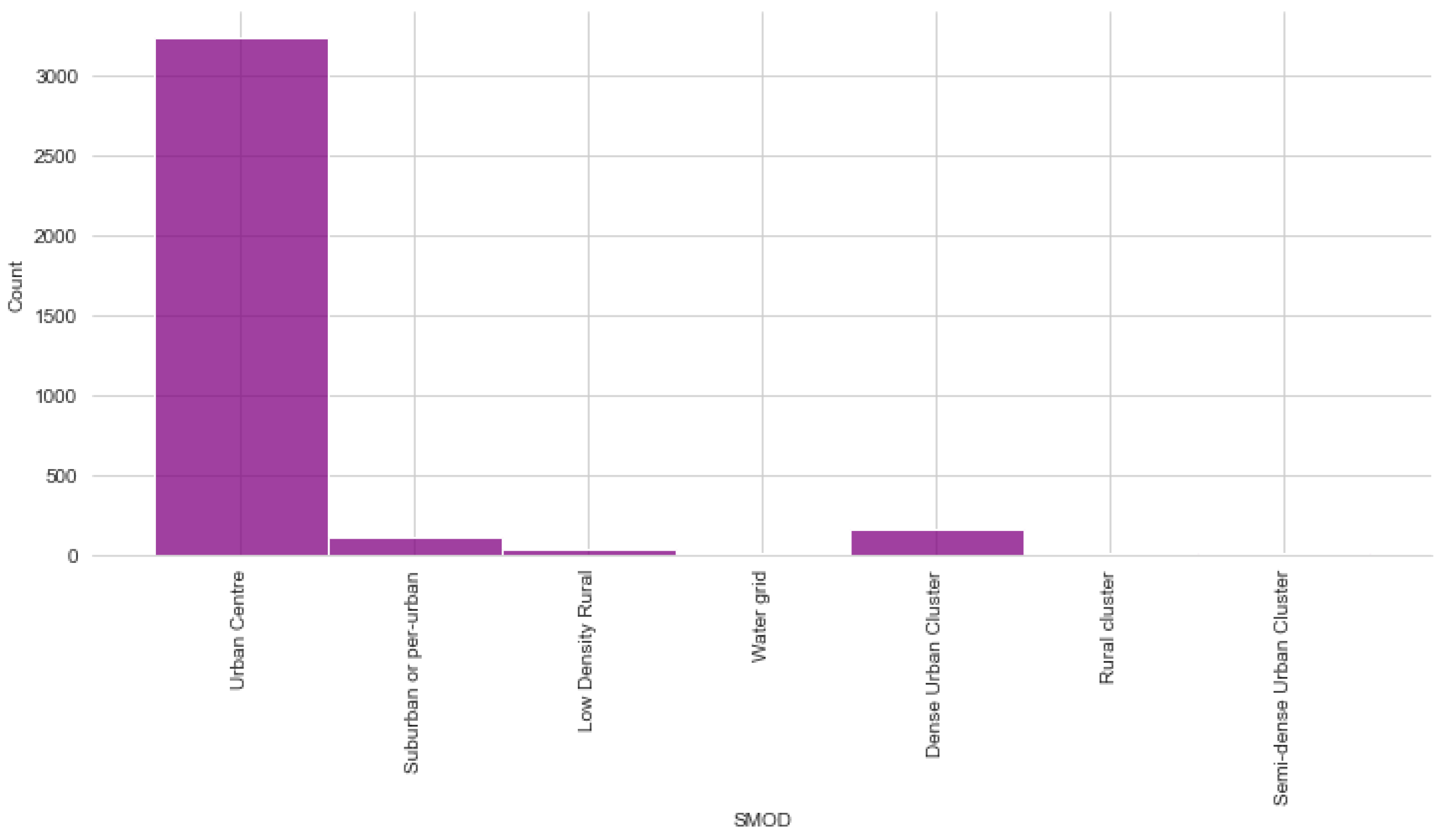
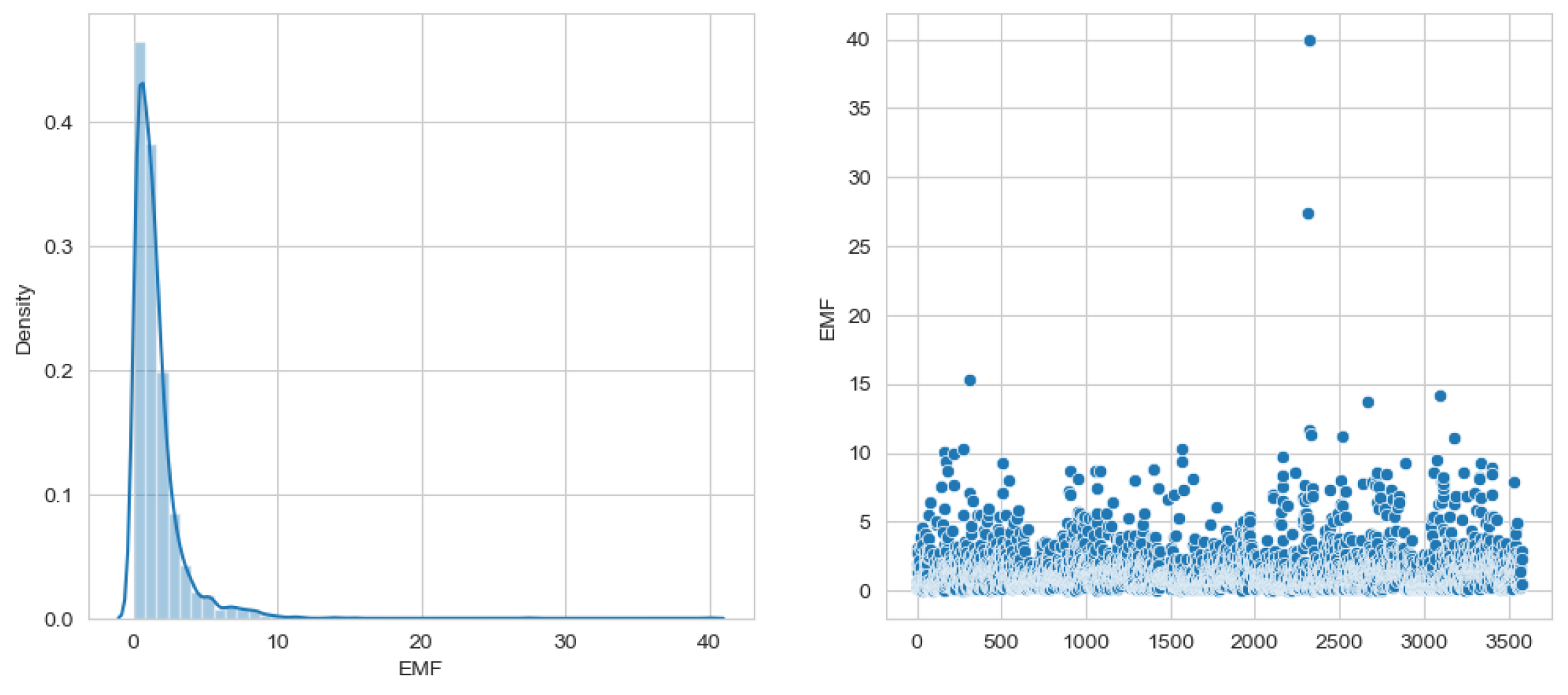

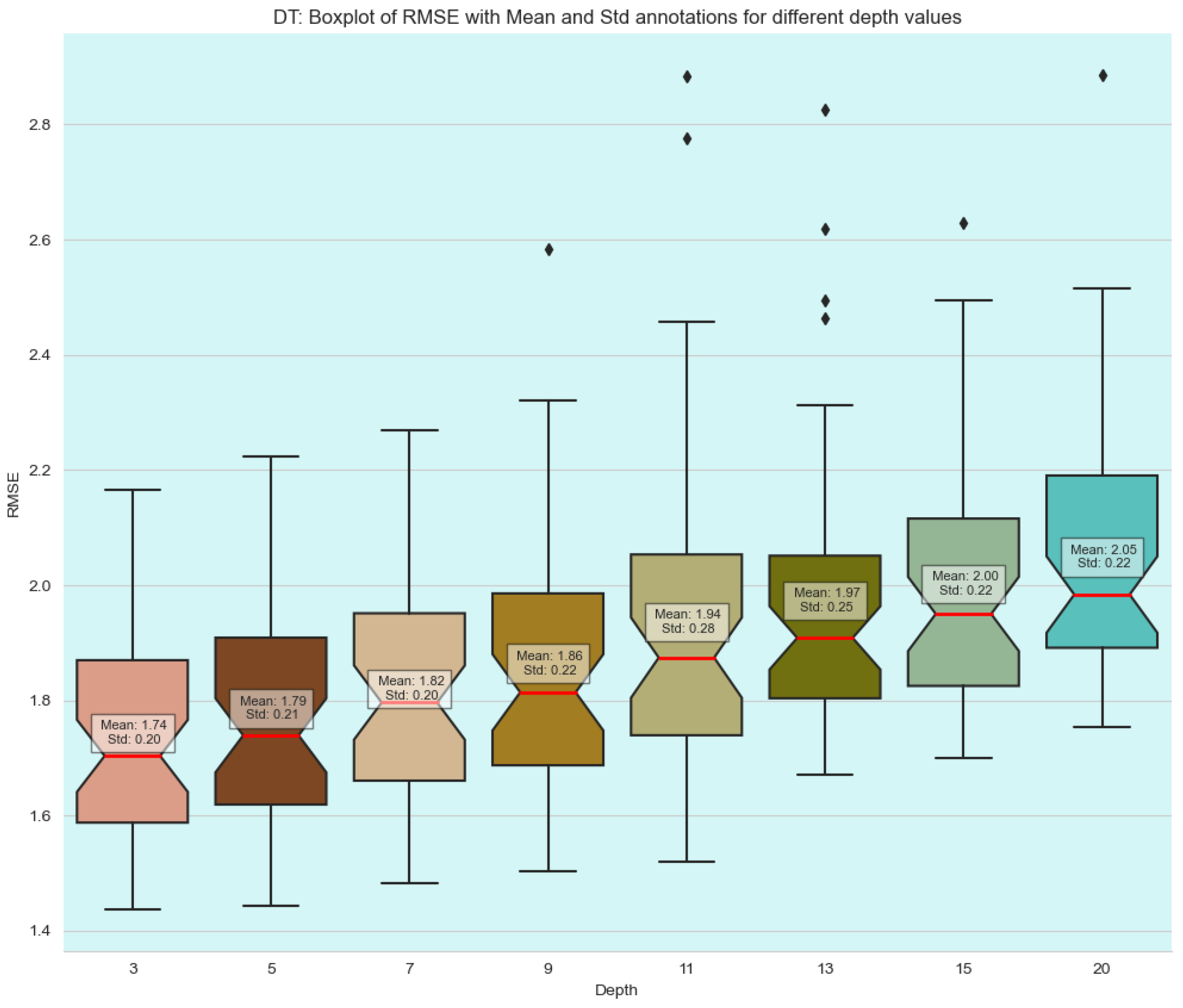
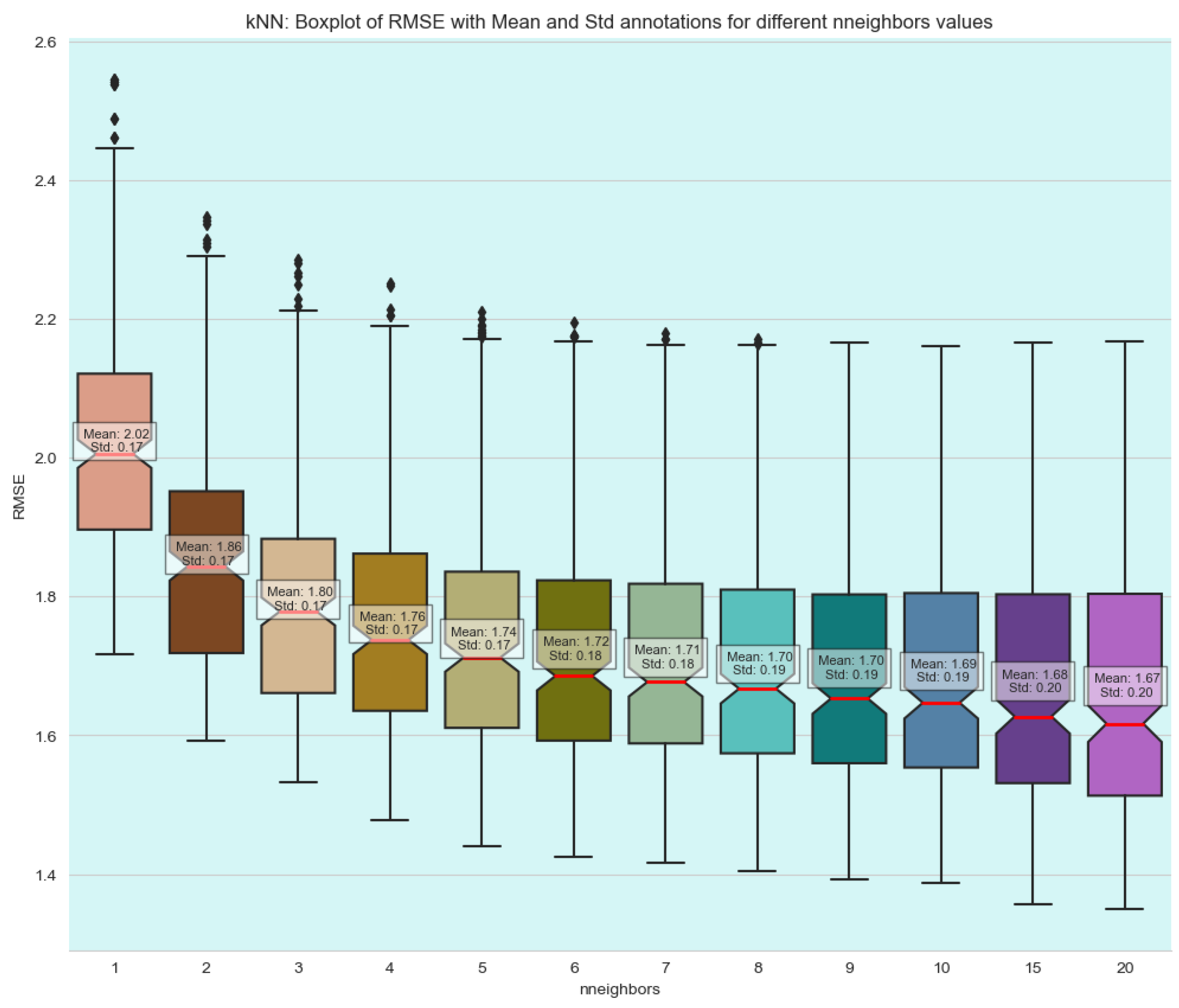
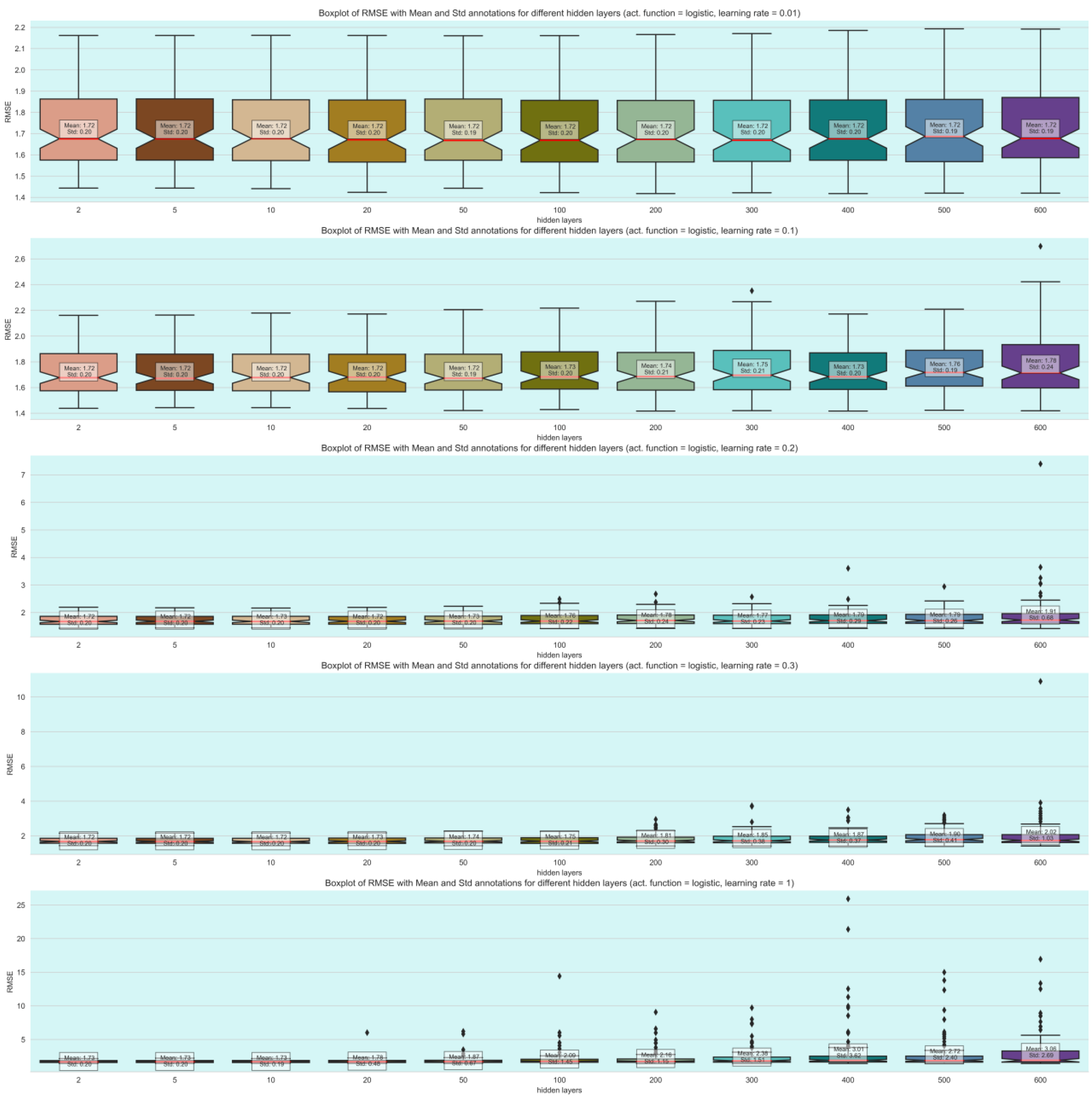

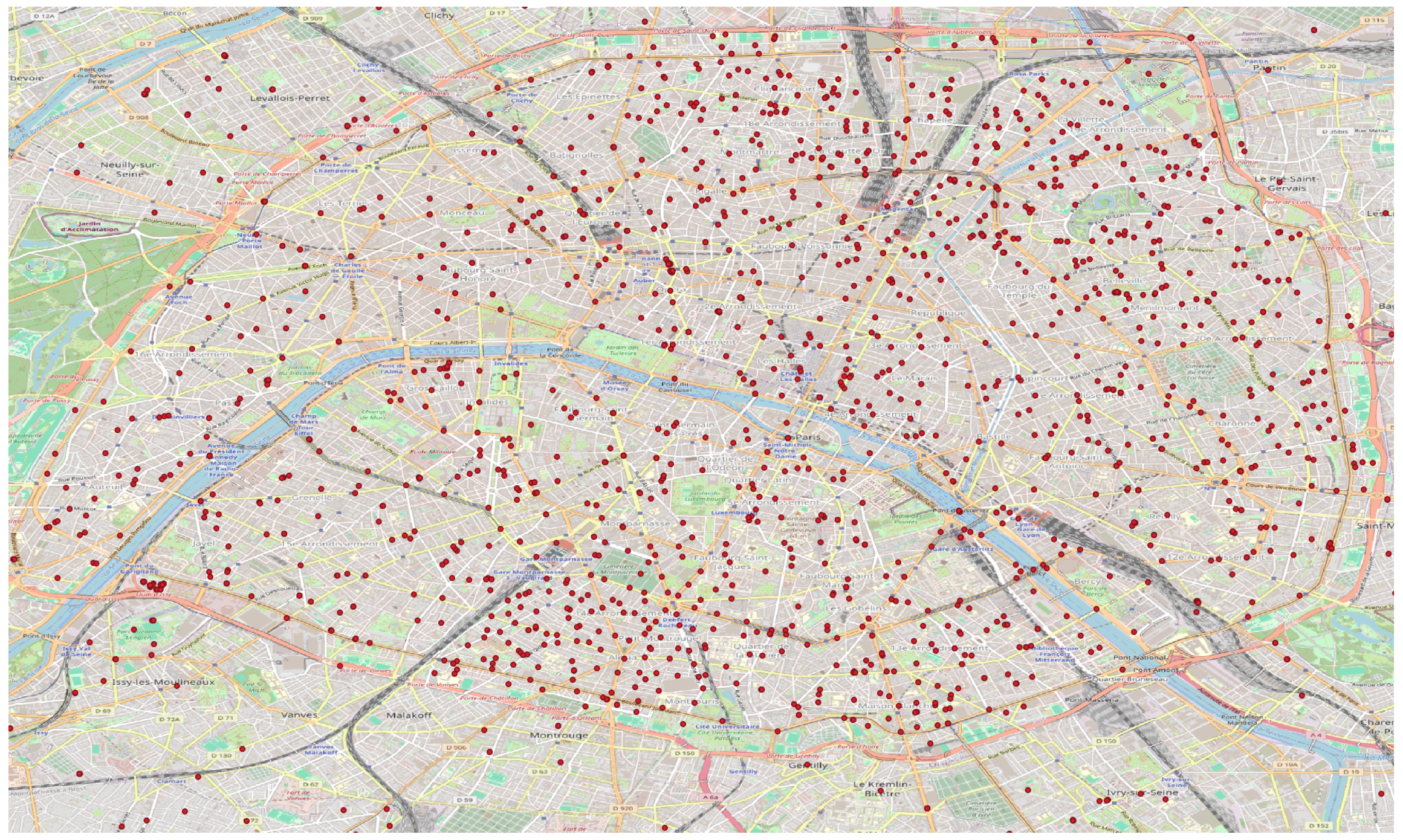
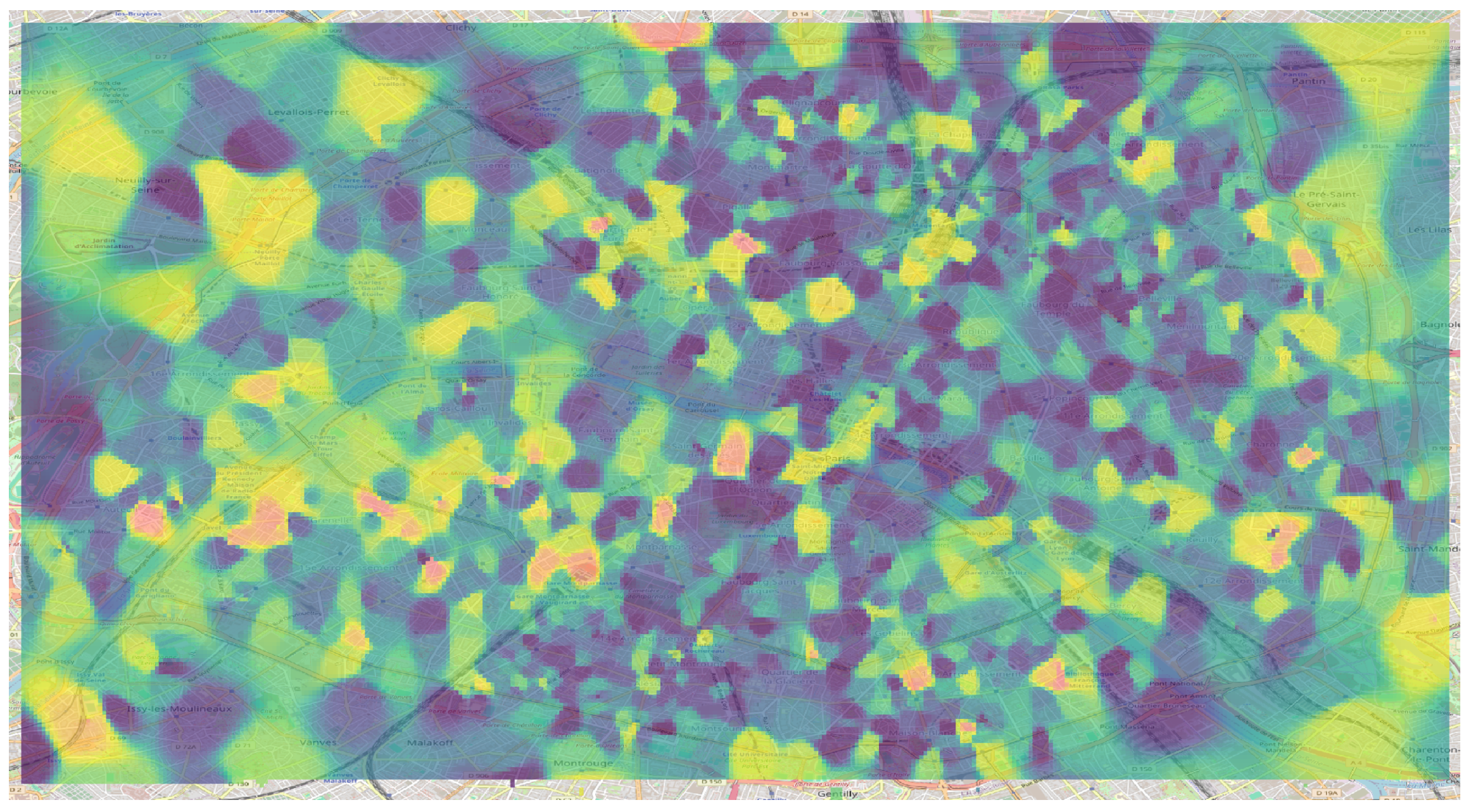

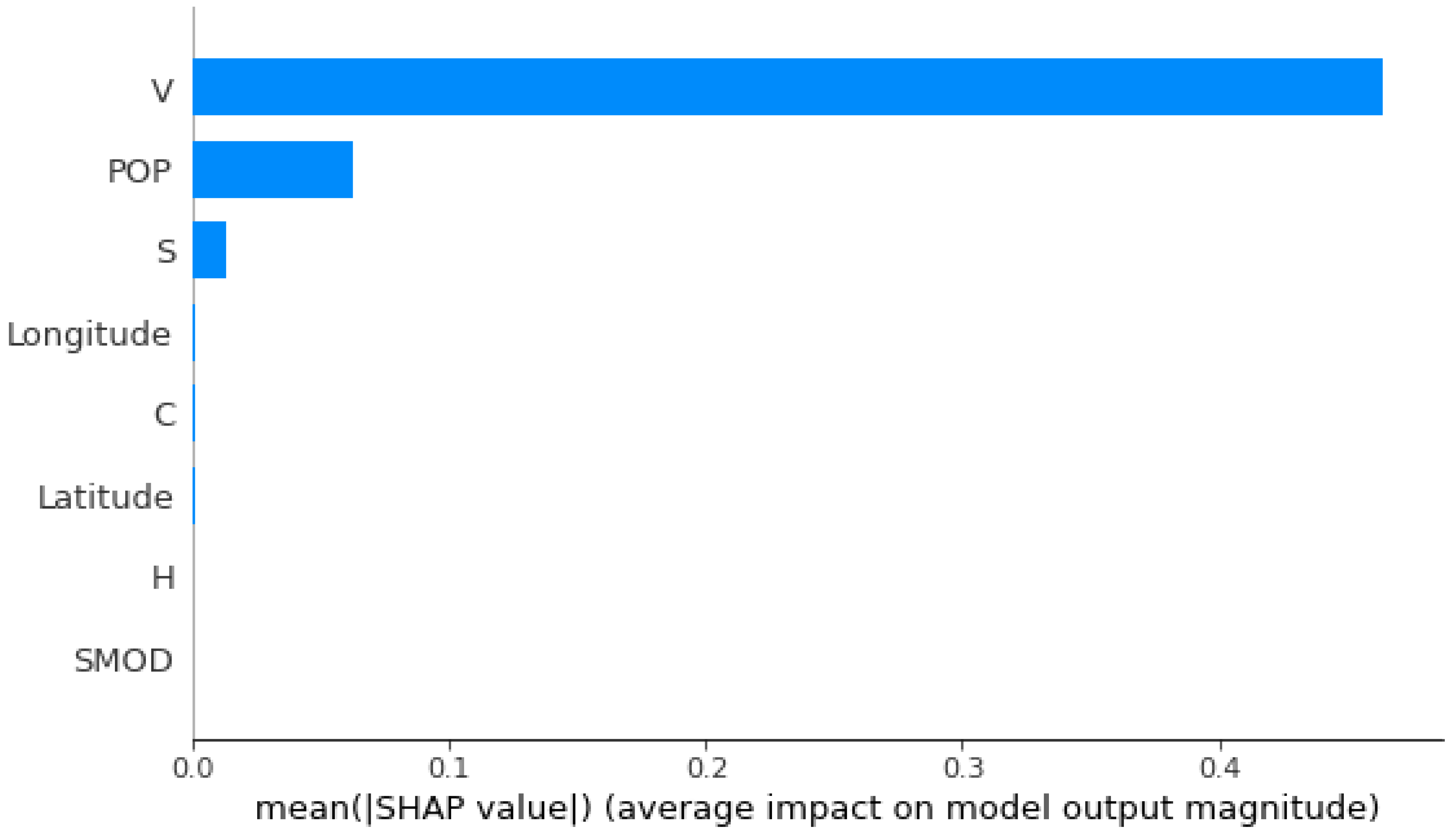
| Statistic | EMF (V/m) | SMOD | POP | V (m3) | H (m) | S (m2) | C |
|---|---|---|---|---|---|---|---|
| Mean | 1.522 | 29.118 | 174.47 | 58,445.95 | 5.84 | 38.12 | 8.57 |
| Std Dev | 1.74 | 3.006 | 144.09 | 32,177.67 | 3.22 | 26.47 | 6.66 |
| Min | 0.00 | 11.00 | 0.00 | 0.00 | 0.000000 | 0.00 | 0.00 |
| 25% | 0.49 | 30.00 | 58.92 | 33,717.00 | 3.37 | 16.00 | 2.00 |
| Median | 1.11 | 30.00 | 130.25 | 54,279.00 | 5.42 | 32.00 | 11.00 |
| 75% | 1.88 | 30.00 | 275.11 | 81,134.00 | 8.11 | 60.00 | 14.00 |
| Max | 39.92 | 30.00 | 824.83 | 306,729.00 | 30.68 | 100.00 | 25.00 |
| Algorithm | Best Hyperparameters | RMSE | SD | Notes |
|---|---|---|---|---|
| Neural Networks | 5 hidden layers, learning rate = 0.01, logistic | 1.72 | 0.77 | Performed poorly overall, except for this combination of hyperparameters. |
| Decision Trees | depth = 3 | 1.74 | 0.20 | Second-best performance in terms of RMSE. |
| k-nearest neighbors | k = 12, p = 2 (Euclidean distance) | 1.63 | 0.20 | Achieved the best result in terms of both RMSE and stability. |
Disclaimer/Publisher’s Note: The statements, opinions and data contained in all publications are solely those of the individual author(s) and contributor(s) and not of MDPI and/or the editor(s). MDPI and/or the editor(s) disclaim responsibility for any injury to people or property resulting from any ideas, methods, instructions or products referred to in the content. |
© 2025 by the authors. Licensee MDPI, Basel, Switzerland. This article is an open access article distributed under the terms and conditions of the Creative Commons Attribution (CC BY) license (https://creativecommons.org/licenses/by/4.0/).
Share and Cite
Kiouvrekis, Y.; Psomadakis, I.; Vavouranakis, K.; Zikas, S.; Katis, I.; Tsilikas, I.; Panagiotakopoulos, T.; Filippopoulos, I. Explainable Machine Learning-Based Electric Field Strength Mapping for Urban Environmental Monitoring: A Case Study in Paris Integrating Geographical Features and Explainable AI. Electronics 2025, 14, 254. https://doi.org/10.3390/electronics14020254
Kiouvrekis Y, Psomadakis I, Vavouranakis K, Zikas S, Katis I, Tsilikas I, Panagiotakopoulos T, Filippopoulos I. Explainable Machine Learning-Based Electric Field Strength Mapping for Urban Environmental Monitoring: A Case Study in Paris Integrating Geographical Features and Explainable AI. Electronics. 2025; 14(2):254. https://doi.org/10.3390/electronics14020254
Chicago/Turabian StyleKiouvrekis, Yiannis, Ioannis Psomadakis, Kostas Vavouranakis, Sotiris Zikas, Ilias Katis, Ioannis Tsilikas, Theodor Panagiotakopoulos, and Ioannis Filippopoulos. 2025. "Explainable Machine Learning-Based Electric Field Strength Mapping for Urban Environmental Monitoring: A Case Study in Paris Integrating Geographical Features and Explainable AI" Electronics 14, no. 2: 254. https://doi.org/10.3390/electronics14020254
APA StyleKiouvrekis, Y., Psomadakis, I., Vavouranakis, K., Zikas, S., Katis, I., Tsilikas, I., Panagiotakopoulos, T., & Filippopoulos, I. (2025). Explainable Machine Learning-Based Electric Field Strength Mapping for Urban Environmental Monitoring: A Case Study in Paris Integrating Geographical Features and Explainable AI. Electronics, 14(2), 254. https://doi.org/10.3390/electronics14020254






